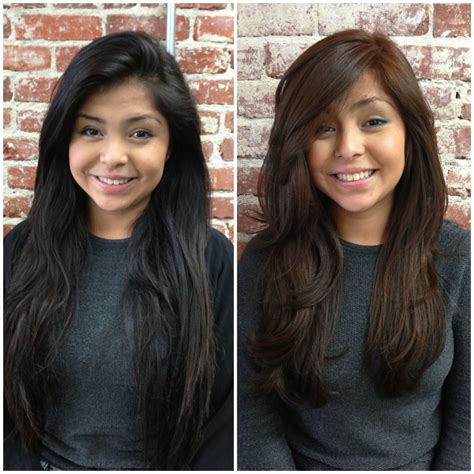Deciphering the Journey from Black to Vibrant Locks
Going from black to a different hair color is a transformative journey that can unveil a new dimension of your style. However, understanding the process and potential challenges is crucial before embarking on this hair-coloring adventure.

Understanding the Gradient of Color Change
The transition from black to other colors involves a progressive lightening process. The darker your starting shade, the more steps and treatments required.
- Natural Black (Level 1): The darkest hair color level, requiring multiple sessions for significant lightening.
- Dark Brown (Level 2): A closer shade to brown, allowing for easier color removal and broader color options.
- Medium Brown (Level 3-4): A transitional stage, providing greater flexibility for color choices and less damage.
- Light Brown (Level 5-6): A lighter base that enables a wider range of hair color transformations.
- Blonde (Level 7-10): The lightest hair color range, typically achieved through multiple bleaching sessions.
Common Mistakes to Avoid
- Over-bleaching: Excessive bleaching can weaken and damage hair, leading to breakage.
- Inadequate lightening: Insufficient bleach can result in uneven color removal, leaving unwanted brassiness.
- Neglecting hair care: Color-treated hair requires extra care, including deep conditioning and color-safe shampoos.
- Improper color application: DIY coloring can lead to uneven, patchy results.
- Unrealistic expectations: Black hair requires patience and multiple sessions to achieve desired color transformations.
Step-by-Step Approach to Color Transformation
- Consultation: Seek advice from a professional hair stylist to determine the most suitable color and lightening strategy.
- Lightening: Gradually lighten the hair using professional treatments tailored to black hair.
- Color Application: Apply the desired hair color once the base has been sufficiently lightened.
- Toners and Glazes: Balance and adjust the final color tone to enhance vibrancy and longevity.
- Maintenance: Maintain the new hair color with regular touch-ups, color-safe products, and proper hair care.
Comparative Analysis of Color Options
Brown:
- Pros: Versatile, complementary to most skin tones, low maintenance.
- Cons: Can be limiting in terms of color choices, still requires lightening.
Red:
- Pros: Bold, statement-making, available in various shades.
- Cons: Fades quickly, requires frequent touch-ups, can be challenging to achieve.
Blonde:
- Pros: Drastic transformation, youthful appearance, endless color possibilities.
- Cons: High maintenance, prone to dryness and damage, requires multiple bleaching sessions.
Balayage and Ombre:
- Pros: Gradual color blends, natural-looking, versatile.
- Cons: Can be time-consuming to achieve, may require multiple sessions.
Unveiling the Vast Array of Hair Colors for Black Hair
Vibrant Hues for a Daring Transformation
- Emerald Green: A luscious, captivating shade that complements olive skin tones.
- Royal Blue: A bold, regal color that turns heads and makes a statement.
- Fuchsia: A playful, vibrant shade that exudes creativity and uniqueness.
- Electric Violet: A deep, mesmerizing color that adds a touch of mystery and allure.
Subtle Enhancements for a Sophisticated Look
- Ash Brown: A cool-toned brown that adds depth and dimension to black hair.
- Chocolate Cherry: A warm, chocolatey shade with a hint of burgundy, perfect for a rich and elegant look.
- Espresso: A deep, coffee-inspired shade that adds a touch of warmth and sophistication.
- Caramel Brunette: A light, golden-brown shade that illuminates black hair and creates a sun-kissed effect.
Creative Inspiration for Hair Color Alchemy
Chromesthesia: A captivating concept where specific hair colors evoke different musical notes, creating a harmonious symphony of style and sound.
Geocoloration: A trend that incorporates elements of geography into hair color, such as the vibrant greens of rainforests or the icy blues of glaciers.
Tables for Comprehensive Understanding
Table 1: Hair Color Transformation Timeline
| Color Transformation | Number of Sessions | Time Frame |
|---|---|---|
| Black to Dark Brown | 1-2 | 4-8 weeks |
| Black to Medium Brown | 2-3 | 8-12 weeks |
| Black to Light Brown | 3-4 | 12-16 weeks |
| Black to Blonde | 4-6 | 16-24 weeks |
Table 2: Color Maintenance Frequency
| Color Transformation | Touch-Up Frequency |
|---|---|
| Brown | Every 6-8 weeks |
| Red | Every 4-6 weeks |
| Blonde | Every 3-4 weeks |
| Balayage/Ombre | Every 8-12 weeks |
Table 3: Hair Care Tips for Color-Treated Hair
| Tip | Description |
|---|---|
| Deep Conditioning | Nourish hair weekly with deep conditioning treatments to restore moisture. |
| Color-Safe Shampoo | Use shampoos specifically designed for color-treated hair to preserve vibrancy. |
| Heat Protection | Protect hair from heat styling tools with heat protectant sprays. |
| Regular Trims | Remove split ends to maintain healthy hair and prevent breakage. |
Table 4: Professional Color Transformations
| Service | Description |
|---|---|
| Balayage: | Hand-painted, freehand hair coloring technique that creates a natural-looking gradient. |
| Ombre: | Gradual transition from one hair color to another, typically from dark to light. |
| Color Melt: | Seamless blend of multiple hair colors, creating a fluid, ombre-like effect. |
| Root Smudge: | Blending of root color into the hair length for a soft, lived-in look. |
Embracing the Adventure of Hair Color Transformation
Going from black to a different hair color can be a thrilling and transformative experience. By approaching it with knowledge, patience, and care, you can unveil a new dimension of your style that reflects your individuality and ignites your creativity.
